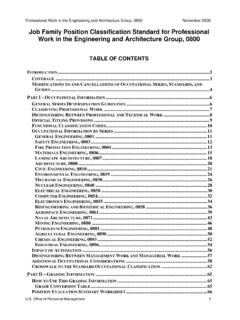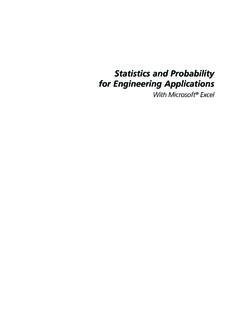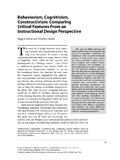Transcription of Systems Engineering: Roles and Responsibilities
1 1 Systems engineering : Roles and Responsibilities NASA PI-Forum, July 27, 2011 Annapolis, MD Dr. Steve Jolly Sensing & Exploration Systems Lockheed Martin Space Systems Company 2011 Lockheed Martin Corporation. All Rights Reserved 2 Making Decisions With Uncertainty Engineers are Relatively Good at Logical Decisions The Problem is With the Assumptions .. Testing the Assumptions is the Most Important Trait of a Good Systems Engineer -Remember You are the Easiest One to Fool In Most Cases, an 80% Solution is Good Enough, but not always! Mars Surface 175 km 135 km Navigation B-Plane Plot 3 Sigma Target Ellipse * * * * * * * * * * * * * * Solutions should have tighter overall grouping! (Hindsight) This is Where We Really Were!
2 This is Where the Data Said We Were Controllability Limit 57 km 3 Systems engineering Key Lessons Truth of DeLuca s Law (from Political Savvy) [Space System development is] Not a rational system that happens to involve humans, but a human system attempting to act rationally Configuration control is good Even very early in project life cycle All mistakes are stupid We miss the obvious Test Like You Fly (TLYF)/Test at System Level cannot be the only verification approach Need to do things right the first time (at lowest level) Distraction can be dangerous We miss the critical while focused on the urgent Non-linear affect of requirements creep 4 Mars 98 Project Science Fixed (Growth) Risk Only Variable Schedule Fixed Cost Fixed Launch Vehicle Fixed (Some Relief) Inadequate Margins Lessons Which We Must Not Re-Learn!
3 5 Systems engineering Precepts Working Definition: The art and science of guiding the end-to-end engineering of complex space Systems Art because it involves extensive people skills and leadership Science because it requires rigorous applications of tools and methodologies Key Objectives 1. Employ First Principles Approach Keep the critical-to-customer requirements always in mind Everything else supports these 2. Bring the entire project together Big Tent, end-to-end, Diversity of ideas are good 3. Vertical and horizontal integration 4. Verification and validation Separate disciplines Little i V&V 6 Systems engineering Leads the Technical Execution of the Project! Accomplished by Establishing the Technical Rhythm (Cadence) by Which the Project Marches This is the Weekly/Periodic Procedure that: Controls Changes to the Technical Baseline Matures the System through the Project Life-Cycle Reduces/Accepts System Risk Directly affects the Life-Cycle Cost Outcome Needs to be In-Place at Contract Start Can be Tailored for Early Phases in the Life-Cycle Must Not Strangle the Project with Many Meetings Attendance and Periodicity Carefully Architected Everyone Hates Long, Fruitless, Unstructured Meetings Except for Dilbert s Meeting Moth.
4 7 Systems engineering P3 People, Processes, Products System of Systems engineering : Innovations for the 21st Century, Edited by Jamshidi, , Jolly and Muirhead, Wiley 2009 8 People Leaders Integrators (Subsystem Superstars) Analysts Open Culture Inclusive 9 Horizontal Integrators System Design and Integration Lead* System Verification & Validation Lead G&C Systems Engineer Chief Systems Engineer Software Systems Engineer Mechanical Systems Engineer Avionics Systems Engineer Risk Manager Navigation Systems Engineer Comm Systems Engineer System Requirements Lead Payload Systems Lead Mission Operations Lead Mission Analysts, FP, Specialty V&V SE s Testbed Lead Payload SE s Example Systems engineering Organization 10 Developing System of Systems Engineers General Characteristics Elements of Training Seen in Practice Generalist, Architect, Firefighter On the job training, how work gets done.
5 Mentoring Know what they know and what they don t know Intellectually curiosity, self-confident, energetic Hands-on experience, end-to-end ownership develops judgment Big picture, end-to-end, concept to operations, the Systems View Big picture oriented, end-to-end and concept-to-operations thinker Working across subsystems and with new technologies Tracks and knows state of key technical /program resources and their margin Comfortable with change and uncertainty Classes for fundamentals, familiarity with tools, lessons learned Understands difference between requirements & capabilities Good communicator and listener Learn processes as useful tools Knows processes are tools, and not an end to themselves Healthy paranoia Multiple job and project experience Builds in robustness, overlapping capability Team player, works well as part of a diverse team Test and tune decision making skills and judgment Conducts objective trade studies, balances technical and programmatic System of Systems engineering .
6 Innovations for the 21st Century, Edited by Jamshidi, , Jolly and Muirhead, Wiley 2009 11 Processes Baseline Control V&V (as separate processes)/ i V&V Configuration Control Trades System Design Team/ engineering Change Board 12 Comparing Roles of the PI/PM to SE Project Management SE Management Planning Project Management Plan, Integrated Master Plan & Schedule (IMP/IMS) Systems engineering Management Plan (SEMP) IMP / IMS (tech), Processes Organizing Project Org. Chart Work Breakdown Structure (WBS) SE Org. Chart Working Groups, Reviews, Risk Management Staffing Project Manpower Plan, Roll-on/Roll-off, Project Office Staff SE Recruiting, Training, Team Building Controlling Earned-Value Management System (EVMS), Project Reviews, Monthly Management Reviews EVMS, Eng.
7 Change Board (ECB), Tech Metrics, Baseline Control, System Design Team Meetings Directing Policies, Procedures, Training, Supervising, Performance Appraisals Reqt s Development, Verification and Validation, Performance Appraisals 13 Why can t the system be calculated to a first-order on a white board? Why only by Sims and Monte Carlo s .. Rate DampThrough drag pass onLoose Deadbands5 minuteGuardbandAccel Bias Calc@ Drag start 30 minTelemetryPlayback (2)RWAs to Tach Profile Free Desat Start PTEP ower 2ndary GimbalsTransition to Thruster ControlReconfigure TelecomLGA, Carrier only@ Drag start 15 minSlew to Drag Attitude@ Drag start 10 min5 minuteGuardbandStop PTETurn Off 2ndary GimbalsBack to RWA ControlSlew to Vacuum AttitudeBack to Earthpoint@ Drag End + 10 minReconfigure Telecom back to HGAA ccel Bias CalcTelemetryPlayback (3)TelemetryPlayback (1) Danger Will Robinson!
8 Danger .. Image Credits: NASA/JPL 14 There are thousands of ways to fail .. most have not been explored Main Chute FailsDrogue FailedStage 1/2 Cutters FailRecontact Damage w/ Jettisoned FBCE nvironment out of Design RangeDisreefing failsControl Lines FailDynamic Pressure Too HighSequence Triggered Too EarlyManufacturing FlawDrogue Prematurely Cut AwatDamage During Packaging/InstallationPlume Impingement DamageMortar DamageAttitude Control ProblemNever InflatesLoads vs. PredictionWas Deployed PrematurelyAgingNever DeployedDesign FlawPilot Chute FailsMortar FailedCommand / Power Chain FailureBreaksStuck/InterferenceTangled in DrogueDeployment InterferenceDelay b/w Drogue & Main is not SufficientSelf Righting Bags Deploy EarlyDrogue Cutter FailsBad Drogue Cut Away AttitudeFWD Bay Cover Fails to JettisonBad Drogue Cut Away Swing RateTangled with DrogueMains TangleStructural FailureTechnical Performance Measures Management System Resource/Mission PhaseSDRPDRCDRATLO startLaunchMass25%20%15%10%3%Energy/Powe r30%20%15%10%10%Power Switches35%30%20%15%10%CPU Utilization75%60%50%30%20%Memory SSR (Bulk storage)30%20%20%15%10% DRAM75%60%50%30%20% NVM (Flash)
9 75%60%50%40%30% SFC EEPROM75%60%50%40%30%Avionics Serial Port Assignments33222 Bus Slot Assignments32211 Discrete I/O30%20%15% Analog I/O30%20%15% to S/C Link(C)3 db3 db3 db3 db3 dbLink Margin Bit Error Rate (3 sigma) Bandwidth60%60%55%55%50%Mission Data Volume20%20%15%10%10%ASIC/FPGA Gates Remaining40%30%20%15%10%Crew IVA Time40%30%20%10%10%System of Systems engineering : Innovations for the 21st Century, Edited by Jamshidi, , Jolly and Muirhead, Wiley 2009 16 Products Design Reference Mission (OpsCon or CONOP) Master Equipment List Technical Performance Measures (TPMs) Requirements and Verification Database (DOORS) ICDs System Failure Mode and Effects Analysis (Fault Tree approach is best practice) Risk Reduction Test Program Numerous Systems Analyses 17 Example of Time-Domain CONOP/DRM, Phoenix Mars Scout Entry, Descent and Landing (NASA) Radar Activated:E+295 s, L-140s Heat Shield Jettison:E+235 s, L-200s, 11 km, 130 m/s Parachute Deployment:E+220 s, L-215 s, 13 km, Mach Peak Heating:44 W/cm2 Peak Deceleration: Cruise Stage Separation:E-7min Lander Separation.
10 E+399 s, L-36 s, km, 54 m/s Throttle Up:E+402 s, L-33 s, km Constant Velocity Achieved:E+425 s, L-10 s, km, m/s Touchdown:E+435 s, L-0s, 0 km, v= 1 m/s, h< m/s Entry Turn min. Turn completes by Leg Deployments:E+245 s, L-190s Dust Settling/Gyrocompassing:L+0 to L+15 min Fire Pyros for Deployments:ASAP Solar Array Deploy:L+15min Final EDL Parameter Update:E- 12hr; Entry State Initialization:E-10min Entry:E-0s, L-435s, 125 km*, r= km, km/s, = -13 deg Pre-EntryPre-EntryHypersonicHypersonicPa rachuteParachuteLander PrepLander PrepTerminalDescentTerminalDescent Vent Pressurant:L+7 SecLanding at kmElevation (MOLA relative)*Entry altitude referenced to equatorial other altitudes referenced to ground levelNote: Nominal Entry Shown.















